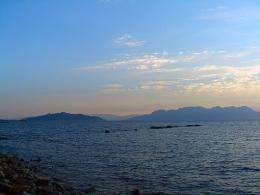Volcanic artifacts imply ice-age mariners in prehistoric Greece

Mariners may have been traveling the Aegean Sea even before the end of the last ice age, according to new evidence from researchers, in order to extract coveted volcanic rocks for pre-Bronze Age tools and weapons.
A new technique which dates obsidian -- volcanic glass which can be fashioned into tools -- suggests that people were mining for obsidian in Mediterranean waters and shipping the once valuable rocks from the island of Melos in modern day Greece as far back as 15,000 years ago.
"Obsidian was a precious natural rock-glass found only in Melos, some in [the modern-day Greek areas of] Antiparos and Yali," explained Nicolaos Laskaris of the University of the Aegean in Greece. "From there it was spread all over the Aegean and in the continent too through contacts of trade."
If you wanted to have sharp tools and weapons in the days before bronze, you needed places like Melos. But you also needed a boat to get there. The evidence that people were crossing over to Melos even before the end of the last ice age comes from obsidian artifacts found in the Franchthi cave on the Peloponnese peninsula in southern mainland Greece -- far from the island of Melos. Previous geochemical work had already established the artifacts were from Melos, but figuring out when they were brought from the island is a trickier problem.
"They were sailors, certainly, especially in the Aegean region they followed little islands jumping like a frog reaching also Asia Minor and the Greek mainland," said Laskaris, who with his colleagues has published a paper about the discovery in the Sept. 2011 issue of Journal of Archaeological Science. "Until now only in Franchthi cave obsidians had been found at circa 8,500 B.C. Now we prove earlier contact with coastal sites was a fact."
Laskaris and his colleagues turned to a method called obsidian hydration dating (OHD) combined with a newer technique known as secondary ion mass spectrometry of surface saturation (SIMS-SS) to determine how much water had penetrated the obsidian surfaces that were exposed to the air by prehistoric humans who were chipping the rocks to make tools and weapons.
"A freshly exposed obsidian surface contains microscopic cracks, into which water absorbs over time," explained researcher Ellery Frahm, of the University of Minnesota Twin Cities, and president-elect of the International Association for Obsidian Studies. The OHD method alone is not very reliable at dating the fractures on the rocks, because it has a couple of serious limitations, she said.
The first is the fact that it’s difficult, when looking at the rock surface through a microscope, to see and measure how deep the fuzzy water diffusion zone penetrates into a rock.
"Where do you measure along this fuzzy line? Second, the diffusion front isn't really where it looks to be. A straw appears to bend in a glass of water due to the difference in refraction index of air and water, so the diffusion front in obsidian isn't really where it appears to be either for the same reason," Frahm explained.
But when SIMS-SS, the new mass spectrometry technique, is added to the picture, scientists can actually quantify the water that penetrates a rock.
"SIMS can directly measure the water in obsidian over a depth," Frahm said. "A particle beam removes ions from the obsidian in extremely thin layers, it is like individually measuring the composition of each onion peel layer." That way the change in water content can be plotted with depth, revealing exactly how it changes.
Using the new SIM-SS method, Laskaris and his colleagues were able to determine that Melos obsidian artifacts were making it to the mainland earlier than previously believed. That naturally implies that people were crossing between islands very early in some unknown types of boats.
Provided by Inside Science News Service

















